What is a Sump Pump Float Switch & How It Works
Most basements are equipped with a sump pump as many homeowners rely on it to avoid flooding and have peace of mind.
Being aware how a sump pump works is important, so that in case something goes wrong you will know how to deal with it.
The sump pump float switch for instance is a key component of any sump pump.
We shall be discussing what it is and how it works in more detail below.
Article Chapters
What is a Sump Pump Float Switch?
The sump pump float switch is a device located in the sump pump which can detect flooding that’s occurring within the sump pit.
Hence, the sump pump float switch controls the water level.
It is responsible for alerting the sump pump to start operating and push the water away from the pit when it starts to fill up.
The float has a round shape and will float on the surface of the water.
In cases where the water in the sump pump starts to rise, the float will rise along with the water.
It is in fact very similar to a float that is commonly found in traditional cisterns.
However in the case of a sump pump float switch, upon reaching a designated height in the sump, it will be automatically activated, leading to the built-up water getting flushed away.
How Does a Sump Pump Float Switch Work?
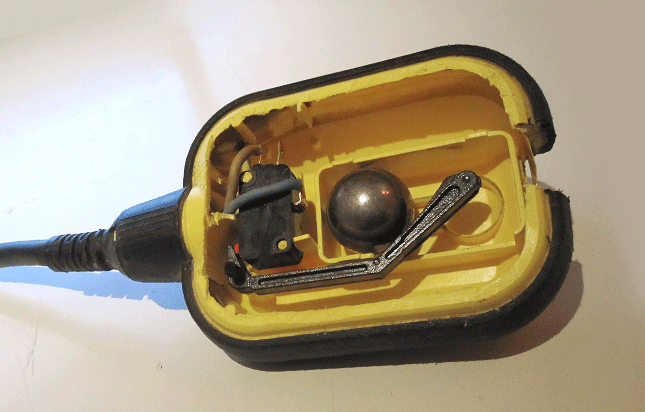
Sump Pump Float Switch Innards. Image credit: Wikipedia
The float switch will move according to the water level in the tank.
Whenever the water level starts to rise, it will rise along with it.
Once it reaches a certain height limit, the switch will close and switch on the sump pump, which in turn discharges the tank.
Whenever the water level drops to a certain level, the switch will open up and stop the pump.
This cycle will be repeated to ensure that the sump pump works properly and efficiently.
Hence the sump pump float switch is of great importance.
Types of Sump Pump Float Switches
There are different types of sump pump float switches, varying in terms of their construction as well as in how they function.
This depends on the wiring, that is, whether it is normally open or closed.
Let us go over them in some more detail below.
Pump Up Float Switch
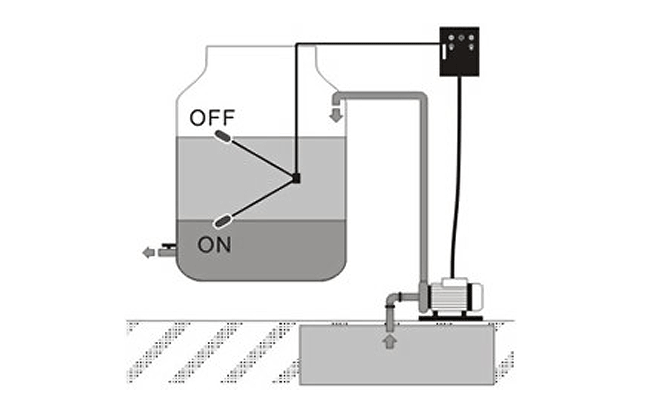
Pump Up Float Switch. Image credit: HCP
Pump-up float switches are normally closed.
They work with sump pumps which fill storage tanks.
This type of switch will be at the top of the storage tank.
When the water level rises, the float switch will also rise.
The switch in the float will open, thereby turning the pump off, and preventing the storage tank from filling further.
The power for the sump pump will first route to the float switch at the top of the tank, and then to the pump which fills the storage tank.
Pump Down Float Switch
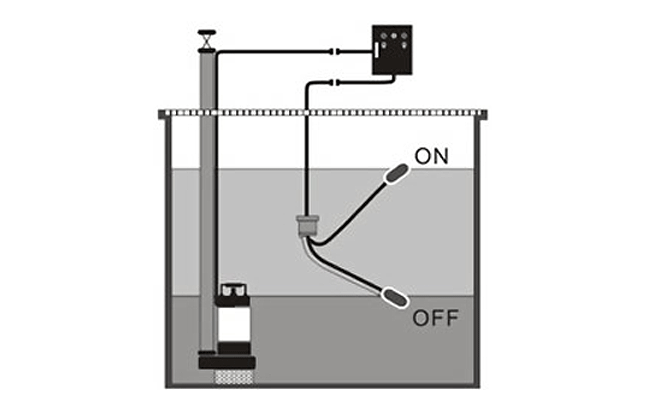
Pump Down Float Switch. Image credit: HCP
The pump-down float switches work with pumps that empty a tank.
Thus these are normally open.
These switches are generally between 4 to 6 inches above the pump suction.
The float switch will shut off the pump before it runs out of water completely.
This prevents it from starting to suck air, as in case this occurs it would significantly affect the lifespan.
Whenever the water level increases, the switch inside the float will close.
The pump will then turn on and start to remove the water from the tank.
As soon as the water level decreases, the switch in the float will fall down, while the internal switch will open so that the pump can be turned off.
Tethered Float Switch
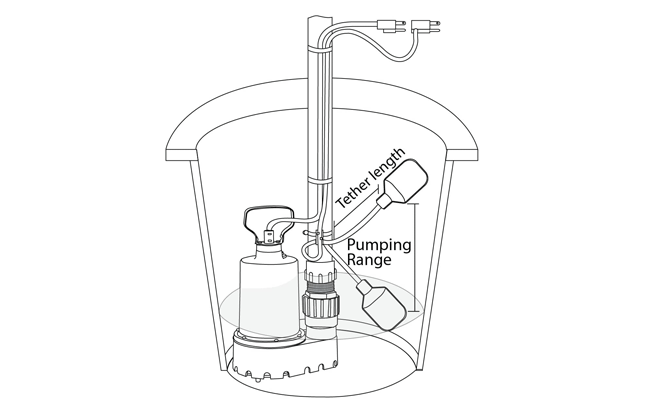
Tethered Float Switch. Image credit: Superior Pump
Tethered float switches have a floating element which lowers and rises according to the water level within the sump basin.
The switch creates a closed circuit which triggers the pump when the level surpasses a certain height.
A tethered float switch mechanism comprises a floating hollow body and there is a steel ball within.
The floating element will be attached to the pump by means of a cord.
Whenever the float pivots, this internal ball will move and operate an electrical switch.
These types of switches have the drawback that they need a large basin in order to move up and down.
And, the longer the cord is, the larger the risk that the float could tangle up in the basin.
Vertical Float Switch
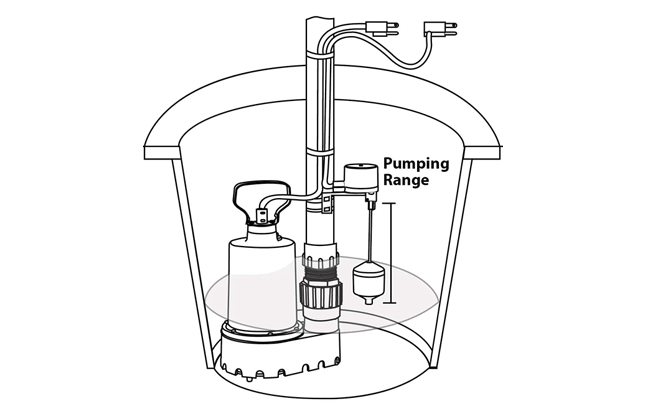
Vertical Float Switch. Image credit: Superior Pump
Vertical float switches are typically used in smaller basins which have a relatively low depth.
The most simple designs will have a floating element which connects to the switch by means of a rod.
Whenever the floating element rises, the rod will push against a lever which operates an electrical switch.
There are also other designs that comprise a floating element that slides over a rod.
This floating element contains a magnet which operates the reed switches whenever certain points in the rod are crossed.
Diaphragm Float Switch
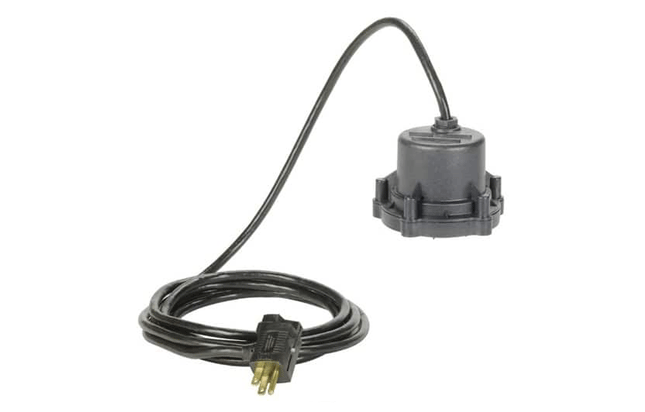
Diaphragm Float Switch. Image credit: Overstock
These types of switches have a diaphragm which deflects under pressure.
Whenever the level rises, the increase in the pressure will result in the diaphragm to deflect, and in turn the switch operates.
Electronic Float Switch
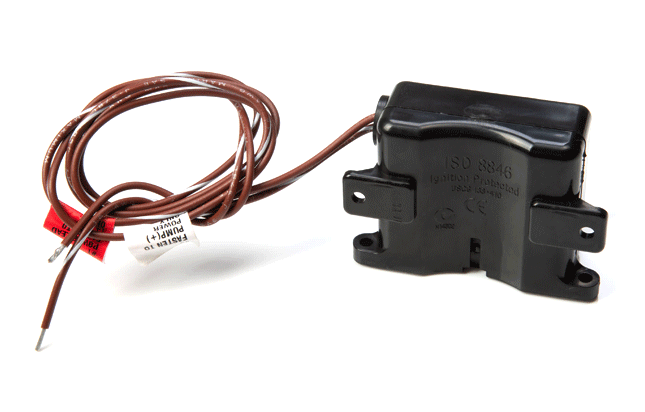
Electronic Float Switch. Image credit: SVB
These types of switches have almost no moving parts, and as a result they are considerably reliable.
The switch will have probes at which the switch should turn on.
A small current will apply to the probes when they are in the water.
The water presence will be detected by means of a sensor that measures the electrical resistance that results.
What Causes a Sump Pump Float Switch to Fail?
Sump pump float switches can fail as a result of various causes or reasons, including;
External Interference
The floating element could get tangled up in the basin.
It could get trapped between the basin wall and the pump.
As a result it will not be able to rise or drop.
Excess Use
Excessive usage may lead the float switch to fail.
Needless to say there will be wear and tear, and in this case, since there’s moving and working parts, it’s even more of an issue.
After several cycles of rising and falling in the sump pump, the float switch could stop reacting to the differences in the water level, or break.
Age
As with anything else, age is a determining factor.
If the float switch has been in use for several years, it’s to be expected that chances of failure will increase over time.
Wear & Tear (Mechanical Failure)
The float switch might stop reacting to the level of the water in the sump after some time due to wear and tear.
Following numerous lifting and lowering cycles the switch may end up failing.
In this case it will need to be replaced.
Power Cuts
Both the pump and the float switch are electromechanical devices.
So they will not be able to operate in case of a power failure.
What Happens When a Sump Pump Float Switch Fails?
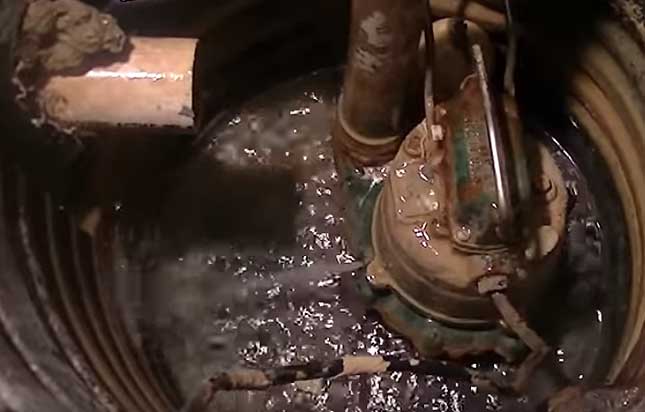
If a sump pump float switch fails, the sump pump may not turn on when needed, leading to potential flooding and water damage leaving the sump pump drainage system redundant.
Alternatively, the sump pump may run continuously, even when there is no water in the sump pit, which can cause the motor to overheat and fail prematurely.
Here are some common problems that can occur when a sump pump float switch fails:
Sump Pump Doesn’t Turn On
If the float switch fails to activate the sump pump motor, the water level in the sump pit will continue to rise, potentially leading to flooding.
Sump Pump Runs Continuously
If the float switch is stuck in the “on” position, the sump pump may run continuously, even when there is no water in the sump pit. This can cause the motor to overheat and fail prematurely.
Switch Stuck in “OFF” Position
In this case, the sump pump will not turn on even when the water level in the sump pit rises to a dangerous level.
Switch is Obstructed
If the float switch is obstructed by debris in the sump pit, it may not be able to move freely and may fail to activate the sump pump motor.
Ways to Avoid a Sump Pump Float Switch Failure
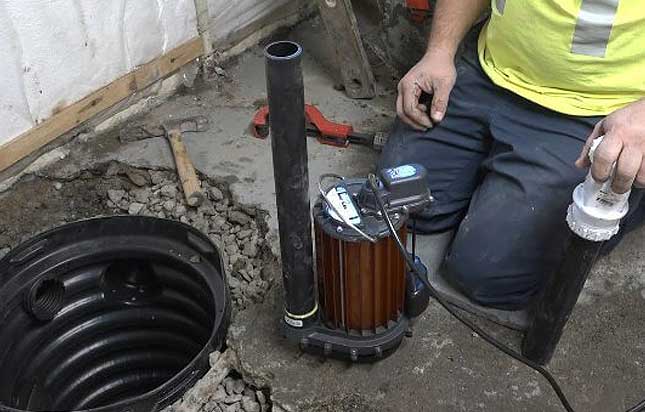
There are several ways to avoid sump pump float switch failure:
Regular Maintenance
Regular sump pump maintenance is important to ensure the pump and its components are working properly.
It’s recommended to inspect and clean the sump pump and float switch at least twice a year.
Clear Debris
Make sure that the sump pit is clear of debris, such as rocks, dirt, and other materials that can obstruct the float switch or damage the sump pump.
Install a Backup System
Installing a battery-powered backup sump pump system can provide additional peace of mind.
It will ensure that the sump pump continues to function in the event of a power outage or primary sump pump failure.
Test the Float Switch
Test the float switch regularly by pouring water into the sump pit to make sure the switch is activating the sump pump motor at the correct water level.
Upgrade the Switch
Consider upgrading to a more reliable float switch such as an electronic float switch or dual float switch, which are less prone to failure than mechanical switches.
Professional Installation
Have a professional sump pump engineer install the sump pump and float switch to ensure it is installed correctly.
This helps to avoid any potential problems that can occur due to improper installation.
Conclusion
We hope that by now you have a clear idea what a sump pump float switch is, how it works, and how to deal with it in case of failure so that you can prevent any flooding and related problems.


Comments are closed.